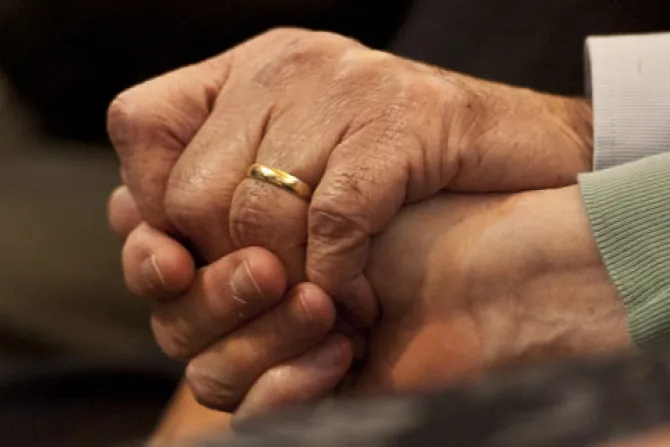Vatican City, Nov 15, 2014 / 06:17 am
One month after the intensely media-centric Synod on the Family, experts are gathering once again in the Vatican to explore man and woman's complementarity, using "new and creative language to speak to people where they are."
This is according to Helen Alvaré, professor of law at George Mason University, and communications liaison for the Humanum Colloquium, which will run from Nov. 17-19 at the Vatican.
The gathering is sponsored by the Congregation for the Doctrine of the Faith, in collaboration with the Pontifical Council for the Family, the Pontifical Council for Interreligious Dialogue, and the Pontifical Council for the Promotion of Christian Unity.
The aim of the conference, Alvaré told CNA, is "to assist the entire project of the man and the woman in marriage by helping [to promote] a greater understanding of what this relationship is as a human institution." The gathering seeks to offer support for those "who hope for marriage, but sometimes despair, and for people who are struggling with it if they have it."
Based on the papers which will be presented at the conference, she said, the speakers will be approaching the notion of complementarity by promoting an appreciation for its beauty, as well as its benefits for "men and women at the level of the couple, the level of the family, the level of the community."
The gathering brings together experts from around the world and diverse religious traditions, including Catholic, Protestant, Jewish, Jain, Buddhist, Sikh, Muslim, and so on.
Despite these religious and cultural differences, Alvaré said, the themes linking the presentation on marriage are "so incredibly common that really do get at the reality of the relationship between a man and a woman as a natural human institution."
For instance, one theme which appears across the board, she said, is that of time: namely, the time it takes to understand their relationship, to discover how their similarities and otherness, and the qualities of their interaction "leads both of them to a higher place," and "how their differences are the source of some of their strongest happiness."
Another theme was the beauty of selfgift: namely, "of unselfishness, of avoiding ego, of gift, of service, of sacrifice." This notion of gift, she said, is "globally speaking and interreligiously speaking."
In addition to presentations by experts from a wide range of religious traditions, the three day gathering includes the showing of these short films about the family: "The Destiny of Humanity: On the Meaning of Marriage," "Understanding Man and Woman," and "Challenge and Hope for a New Generation".
The videos were chosen because "visuals, beauty is an important component of teaching, of persuading, and also of helping," Alvaré said. "It's something new, useful, beautiful, that touches people in a place where maybe words don't touch them, or haven't yet. It's a classic approach, a classic way that the Church in the past has spoken. It's a way that the world is attempting to characterize the relationship between the man and the woman."
Although the agenda for the colloquium was set long before last month's Extraordinary Synod on the Family, Alvaré said the interventions which will be delivered nonetheless answer the call made by the Synod fathers to find new ways to speak old truths.
"And that is, I would say, a hallmark, maybe even the soul, of this conference."
The witnesses given by representatives of more than a dozen different religious traditions, Alvaré said, "are in and of themselves something creative and new." She also cited the beautiful imagery provoked by the short films which will be featured on each day of the conference, using "what art has always been to the Church a way of communicating truths in a different fashion."
The final document of the Synod also addressed the need to invite "the witness of men and women the world over". This is achieved by the films, she said, in their representation of men and women from diverse states in life: married and single, young and old, those happy and those struggling, hailing from various cultural and religious traditions.
"The Synod invited this kind of contribution because we are dealing with a human institution experiencing problems that requires a human response," she said. "How do you get that? You look to a wide variety of human beings."
(Story continues below)
Noting how the Relatio spoke about "the couple as sort of the heart of the marriage and family," Alvaré said that this is where colloquium begins: with the couple. It explores "how [this relationship] works, how it's lived, how people struggle with it, stereotypes of it that are false... And that's a great way to begin."



